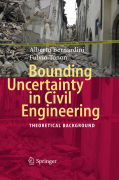
Bounding uncertainty in civil engineering: theoretical background
Bernardini, Alberto
Tonon, Fulvio
In engineering contexts, random sets are useful when there is scarce or imprecise information as well as when a model for the engineering system is imprecise (e.g., discretization errors, different competing models, upper and lower bounds in limit analysis). Random sets generalize the concept of random variables from point measures to set measures; equivalently, they embody a convex setof probability measures. Taking an engineering approach rather than a mathematical one, Random Sets in Civil Engineering is a gentle introduction to the subject that does not require advanced mathematical knowledge. Basic ideas and methods are presented and demonstrated with the aid of simple worked-out examples and suggested problems. Connections are clarified to the more general theory of imprecise probabilities and to other non classical models of uncertainty and approximate reasoning in decision making (e.g., fuzzy sets and evidence theory). The book serves as a reference for practicing engineers involved in planning, design, construction and management of civil infrastructures, as well as a graduate-level textbook. Readers interested in uncertainty modelling will find general solutions and algorithms, which may also be applied to problems in other fields beyond engineering. In the second volume of the book (to be planned in the future), the application of the new methods is demonstrated for selected examples with real case-histories from civil engineering: reliability analysis of structures, soil and rock slopes, rock mass characterization, optimization of tunnel reinforcement and lining, evaluation of seismic vulnerability of buildings and damage scenarios in urban areas." Basic ideas and methods of Random Sets in Civil Engineering are presented with the aid of simple worked-out examples and suggested problems Useful as reference for practicing engineers involved in planning, design, construction and management of civil infrastructures, as well as a graduate-level textbook Provides various applications with real case-histories from civil engineering: reliability analysis of structures, soil and rock slopes, rock mass characterization, optimization of tunnelreinforcement and lining, evaluation of seismic vulnerability of buildings and damage scenarios in urban areas Takes an engineering approach rather than a mathematical one INDICE: Motivation.- Review of Theory of Probability and Notation.- Randomsets and imprecise probabilities.- Random relations.- Inclusion and mappings of random sets/relations.- Approximate reasoning.
- ISBN: 978-3-642-11189-1
- Editorial: Springer
- Encuadernacion: Cartoné
- Páginas: 350
- Fecha Publicación: 01/02/2010
- Nº Volúmenes: 1
- Idioma: Inglés
